As the climbing ban comes into effect, we take a look at the incredible variety of experiences on offer at Uluru-Kata Tjuta National Park above and beyond scaling the Rock.
Anangu traditional owner and artist Malya Teamay – whose artwork appears on the entry ticket to Uluru-Kata Tjuta National Park – has never liked seeing people run the risk of injury – or worse – by attempting to scale the Rock. “Anangu are very sad whenever anybody gets hurt or dies on the climb,” he says. “It’s better if they take a photo.” Since a chain was installed on Uluru’s steep western face in 1964, climbing the monolith has been a tourist attraction; but it has always flown in the face of Anangu’s spiritual beliefs and their polite requests to visitors to refrain from the activity due to cultural and safety reasons.
But as of 26 October, the Uluru climb is officially closed thanks to a unanimous decision from the Uluru-Kata Tjuta National Park board. And in case you’re wondering what else there is to do during a visit to this UNESCO World Heritage-listed cultural landscape, the answer is a lot – more than 100 tours and experiences, in fact. Taking a photo is just the beginning. Here are some highlights.
Since its inception in 2016, Field of Light – Bruce Munro’s site-specific light installation at the base of Uluru – has become a Red Centre bucket-list item in its own right. The good news for those who haven’t visited yet is that its run has been extended again – this time indefinitely. There are a number of ways to experience it (including the Field of Light Pass, which starts at $43 and includes your transfer to the site and a self-guided walk), but the pièce de résistance is A Night At Field Of Light, an exclusive outback dining experience that marries Voyages Ayers Rock Resort’s classic Sounds of Silence dinner with Munro’s installation.
The evening begins with canapés and views of Uluru at sunset (plus Field of Light’s carpet of 50,000 solar-powered glass spheres beginning to come to life for the night below), and evolves as the sun goes down to encompass a three-course bush tucker-infused menu (think native dukkha-crusted kangaroo or barramundi slicked with lemon myrtle cream) and a star talk that guides you through the southern night sky from an Indigenous perspective. It’s capped off by a self-guided tour through the twinkling Field of Light, which looks spectacular in photos but blows you away in real life.
Start the evening by arriving by camel – where a leisurely amble through the red sand dunes at golden hour affords you your first glimpse of Uluru, before you’re met with a glass of sparkling on arrival at the viewing platform – or better yet, helicopter.
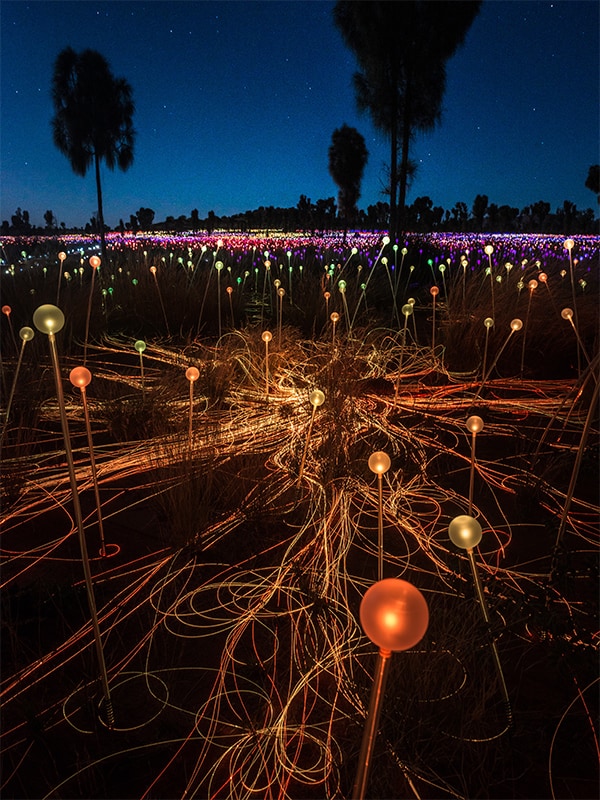
Field of Light has become one of the most synonymous Uluru sights
Segway sceptics, prepare to have your preconceptions dashed as you circle Uluru’s full 12-kilometre base in (relative) speed and style. Fifteen minutes’ practice will have you ready to go – intuitive and self-balancing, Segways are surprisingly easy to operate and perhaps not-so-surprisingly fun, too.
You’ll pass walkers, cyclists and joggers as you cruise along the red-dirt path at a pace that not only whips up a cool breeze but, crucially, allows you to take in both the magnitude of the monolith as well as its texture and nuances: from a distance and in photos we don’t see the many caves, ridges and grooves erosion has left on the Rock but from this vantage point it’s all there to observe.
Along the way your guide will share stories about the incredible geology of Uluru as well as the culture of its traditional owners, Anangu.
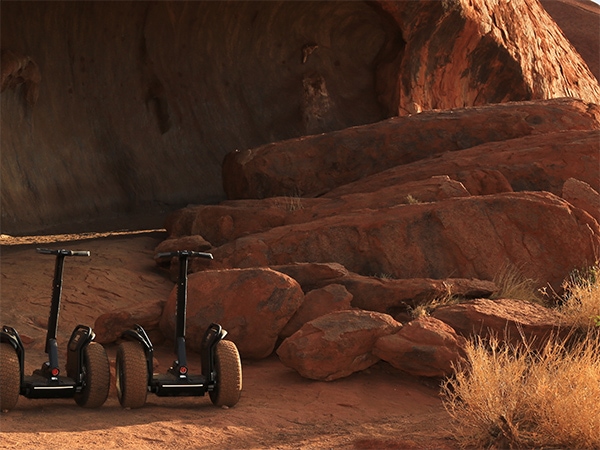
See the rock by Segway
One of the most unforgettable things you can do during your time in the Red Centre is open-air fine-dining experience Tali Wiru. Its name means ‘beautiful dune’ in the local Anangu language, Pitjantjatjara, and sees guests travelling out to a remote southern dune for a champagne arrival at golden hour with musical accompaniment by way of the didgeridoo. While you snack on canapés crafted from bush tucker – think ingredients like green ants, aka gulguk, wild-harvested here in the Northern Territory – you’ll take in a 360-degree view of the desert, the distant domes of Kata Tjuta, and of course Uluru in all its various shades of sundown.
As the still desert night descends, you’ll be seated for an intimate four-course dinner under the stars. Once again, dishes feature native ingredients: think pressed wallaby with charred witlof, pickled grapes, wild garlic, quandong glass and Davidson plum; and toothfish with kombucha and bush honey roasted heirloom carrots, Jerusalem artichoke puree and bush grains. Tali Wiru operates seasonally from March to October.
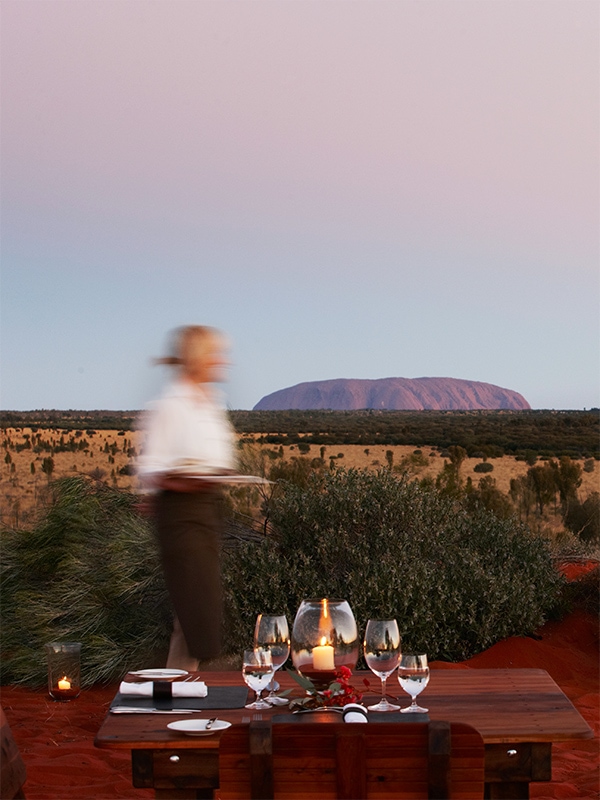
Take in a 360-degree view of the desert when you dine at Tali Wiru
Make a pilgrimage to Uluru-Kata Tjuta National Park’s other iconic rock formations with one of SEIT Outback Australia’s off-the-beaten-track tours. Once known as the Olgas, Kata Tjuta is a Pitjantjatjara term that means ‘many heads’; the 36 domes in question rise up to 546 metres above the desert plain and were formed by the same geological events – beginning 550 million years ago – that left the monolith of Uluru exposed to the elements. The area is sacred under Anangu men’s law and is only accessible to visitors via the Walpa Gorge walk and slightly more challenging Valley of the Winds.
Walk the 7.5-kilometre Valley of the Winds early in the morning before the sun beats down too hard to take in awe-inspiring scenery and feel the iron-rich sandstone almost vibrating underfoot.
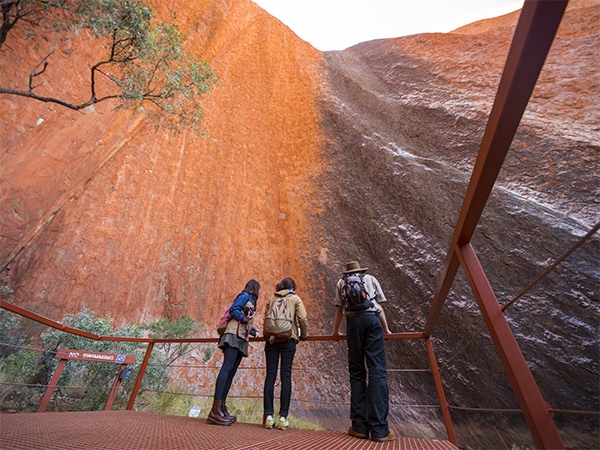
There are numerous guided walking opportunities at Uluru
Maruku is a not-for-profit art and craft corporation that’s owned and operated by Anangu and made up of around 900 artists from over 20 remote communities across the Central and Western deserts. Take part in one of their dot painting workshops at Voyages Ayers Rock Resort to gain an insight into their practice and have fun creating your own artwork.
Anangu paintings are produced for educational and ceremonial purposes as well as the telling of events. In this workshop you’ll come to understand how Tjukurpa – Dreaming, law, stories – is the basis of Anangu culture and worldview and that it’s what each piece of artwork is based on and expresses. You’ll learn the different symbols that make up Tjukurpa and, with the help of a Maruku guide and local artist, recreate your own life story in pigment.
There aren’t many places on the planet better suited to stargazing than right here at Uluru. Outback Sky Journeys provides the chance to explore the galaxy of stars in the southern night sky with Voyages Ayers Rock Resort’s resident astronomer: taking in everything from how ancient cultures used it as a canvas for mythology (the Southern Cross as a possum, anyone?) to exploring different constellations, stars and planets with telescopes.
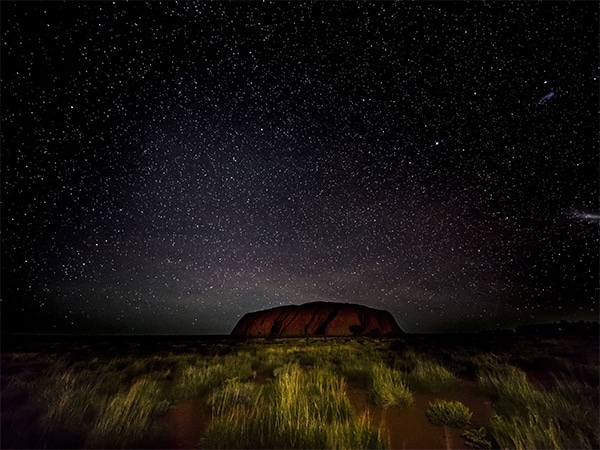
There aren’t many places on the planet better suited to stargazing than Uluru
And five more…
7. Go on a bush tucker journey
Join a free daily bush food experience to learn about native Australian ingredients at Voyages Ayers Rock Resort.
8. Ride a Harley Davidson
Segway not your speed? Try a ride round the Rock on an iconic Harley Davidson instead.
9. Sky dive
True thriller-seekers apply here: for a tandem sky dive taking in the best bits of the Red Centre, from Uluru to Kata-Tjuta, Lake Amadeus and Mt Conner.
10. Walk or cycle Uluru
Join a free ranger-guided Mala Walk to circumnavigate Uluru on foot and visit the painted caves and waterholes of the traditional custodians; or cycle the pathway around the base to explore at your own pace.
11. Take a sunrise tour
This half-day sunrise tour provides the opportunity to see Uluru at its most vivid and spectacular.
Where to stay near Uluru:

